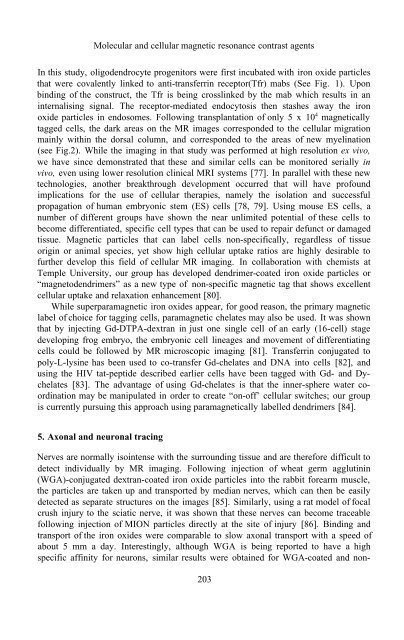Physics And Chemistry Basis Of Biotechnology - De Cuyper - tiera.ru
Physics And Chemistry Basis Of Biotechnology - De Cuyper - tiera.ru
Physics And Chemistry Basis Of Biotechnology - De Cuyper - tiera.ru
You also want an ePaper? Increase the reach of your titles
YUMPU automatically turns print PDFs into web optimized ePapers that Google loves.
Molecular and cellular magnetic resonance contrast agents<br />
In this study, oligodendrocyte progenitors were first incubated with iron oxide particles<br />
that were covalently linked to anti-transferrin receptor(Tfr) mabs (See Fig. 1). Upon<br />
binding of the const<strong>ru</strong>ct, the Tfr is being crosslinked by the mab which results in an<br />
internalising signal. The receptor-mediated endocytosis then stashes away the iron<br />
oxide particles in endosomes. Following transplantation of only 5 x 10 4 magnetically<br />
tagged cells, the dark areas on the MR images corresponded to the cellular migration<br />
mainly within the dorsal column, and corresponded to the areas of new myelination<br />
(see Fig.2). While the imaging in that study was performed at high resolution ex vivo,<br />
we have since demonstrated that these and similar cells can be monitored serially in<br />
vivo, even using lower resolution clinical MRI systems [77]. In parallel with these new<br />
technologies, another breakthrough development occurred that will have profound<br />
implications for the use of cellular therapies, namely the isolation and successful<br />
propagation of human embryonic stem (ES) cells [78, 79]. Using mouse ES cells, a<br />
number of different groups have shown the near unlimited potential of these cells to<br />
become differentiated, specific cell types that can be used to repair defunct or damaged<br />
tissue. Magnetic particles that can label cells non-specifically, regardless of tissue<br />
origin or animal species, yet show high cellular uptake ratios are highly desirable to<br />
further develop this field of cellular MR imaging. In collaboration with chemists at<br />
Temple University, our group has developed dendrimer-coated iron oxide particles or<br />
“magnetodendrimers” as a new type of non-specific magnetic tag that shows excellent<br />
cellular uptake and relaxation enhancement [80].<br />
While superparamagnetic iron oxides appear, for good reason, the primary magnetic<br />
label of choice for tagging cells, paramagnetic chelates may also be used. It was shown<br />
that by injecting Gd-DTPA-dextran in just one single cell of an early (16-cell) stage<br />
developing frog embryo, the embryonic cell lineages and movement of differentiating<br />
cells could be followed by MR microscopic imaging [81]. Transferrin conjugated to<br />
poly-L-lysine has been used to co-transfer Gd-chelates and DNA into cells [82], and<br />
using the HIV tat-peptide described earlier cells have been tagged with Gd- and Dychelates<br />
[83]. The advantage of using Gd-chelates is that the inner-sphere water coordination<br />
may be manipulated in order to create “on-off’ cellular switches; our group<br />
is currently pursuing this approach using paramagnetically labelled dendrimers [84].<br />
5. Axonal and neuronal tracing<br />
Nerves are normally isointense with the surrounding tissue and are therefore difficult to<br />
detect individually by MR imaging. Following injection of wheat germ agglutinin<br />
(WGA)-conjugated dextran-coated iron oxide particles into the rabbit forearm muscle,<br />
the particles are taken up and transported by median nerves, which can then be easily<br />
detected as separate st<strong>ru</strong>ctures on the images [85]. Similarly, using a rat model of focal<br />
c<strong>ru</strong>sh injury to the sciatic nerve, it was shown that these nerves can become traceable<br />
following injection of MION particles directly at the site of injury [86]. Binding and<br />
transport of the iron oxides were comparable to slow axonal transport with a speed of<br />
about 5 mm a day. Interestingly, although WGA is being reported to have a high<br />
specific affinity for neurons, similar results were obtained for WGA-coated and non-<br />
203












